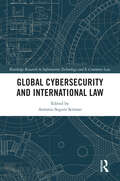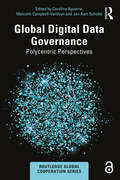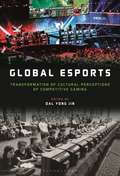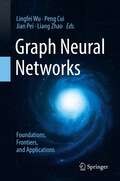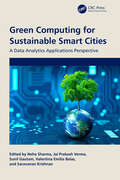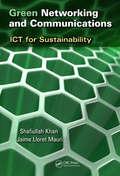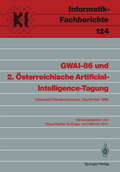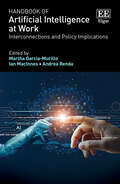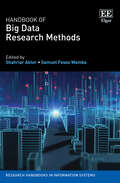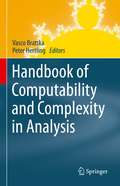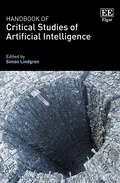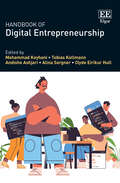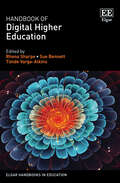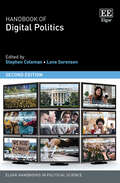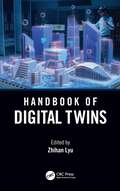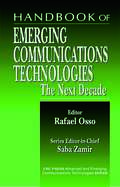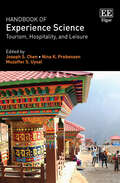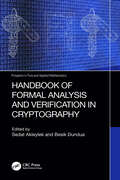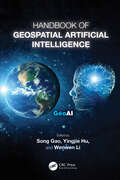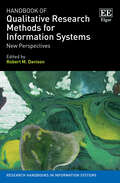- Table View
- List View
German Success Stories in Industrial Mathematics (Mathematics in Industry #35)
This book should illustrate the impact of collaborations between mathematics and industry. It is both an initiative of and coordinated by the German Committee for Mathematical Modeling, Simulation and Optimization (KoMSO). This publication aims at comparing the state of the art at the intersection of mathematics and industry, as well as the demands for future development of science and technology in Germany and beyond.Each contribution addresses the importance of mathematics in innovation by means of introducing a successful cooperation with an industrial partner in order to display the wide range of industrial sectors where the use of mathematics is the crucial factor for success, but also show the variety of mathematical areas involved in these activities. The success stories introduced in this volume will be supplemented by appropriate illustrations.It is the goal of this publication to highlight cooperation between mathematics and industry as a two-way technology and knowledge transfer, providing industry with solutions and mathematics with new research topics and inspiring new methodologies.
Global Cybersecurity and International Law (Routledge Research in Information Technology and E-Commerce Law)
This book offers a critical analysis of cybersecurity from a legal-international point of view.Assessing the need to regulate cyberspace has triggered the re-emergence of new primary norms. This book evaluates the ability of existing international law to address the threat and use of force in cyberspace, redefining cyberwar and cyberpeace for the era of the Internet of Things. Covering critical issues such as the growing scourge of economic cyberespionage, international co-operation to fight cybercrime, the use of foreign policy instruments in cyber diplomacy, it also looks at state backed malicious cyberoperations, and the protection of human rights against State security activities. Offering a holistic examination of the ability of public international law, the book addresses the most pressing issues in global cybersecurity.Reflecting on the reforms necessary from international institutions, like the United Nations, the European Union, the Council of Europe, and NATO, in order to provide new answers to the critical issues in global cybersecurity and international law, this book will be of interest to academics, students and practitioners.
Global Digital Data Governance: Polycentric Perspectives (Routledge Global Cooperation Series)
This book provides a nuanced exploration of contemporary digital data governance, highlighting the importance of cooperation across sectors and disciplines in order to adapt to a rapidly evolving technological landscape. Most of the theory around global digital data governance remains scattered and focused on specific actors, norms, processes, or disciplinary approaches. This book argues for a polycentric approach, allowing readers to consider the issue across multiple disciplines and scales. Polycentrism, this book argues, provides a set of lenses that tie together the variety of actors, issues, and processes intertwined in digital data governance at subnational, national, regional, and global levels. Firstly, this approach uncovers the complex array of power centers and connections in digital data governance. Secondly, polycentric perspectives bridge disciplinary divides, challenging assumptions and drawing together a growing range of insights about the complexities of digital data governance. Bringing together a wide range of case studies, this book draws out key insights and policy recommendations for how digital data governance occurs and how it might occur differently. Written by an international and interdisciplinary team, this book will be of interest to students and scholars in the field of development studies, political science, international relations, global studies, science and technology studies, sociology, and media and communication studies.
Global esports: Transformation of Cultural Perceptions of Competitive Gaming
Global eSports explores the recent surge of eSports in the global scene and comprehensively discusses people's understanding of this spectacle. By historicizing and institutionalizing eSports, the contributors analyze the rapid growth of eSports and its implications in culture and digital economy. Dal Yong Jin curates a discussion as to why eSports has become a global phenomenon. From games such as Spacewar to Starcraft to Overwatch, a key theme, distinguishing this collection from others, is a potential shift of eSports from online to mobile gaming. The book addresses why many global game players and fans play and enjoy online and mobile games in professional game competitions, and therefore, they investigate the manner in which the transfer to, from and between online and mobile gaming culture is occurring in a specific subset of global youth. The remaining focus identifies the major platforms used to enjoy eSports, including broadcasting and smartphones. By analyzing these unexamined or less-discussed agendas, this book sheds light on the current debates on the growth of global eSports culture.
Graph Neural Networks: Foundations, Frontiers, and Applications
Deep Learning models are at the core of artificial intelligence research today. It is well known that deep learning techniques are disruptive for Euclidean data, such as images or sequence data, and not immediately applicable to graph-structured data such as text. This gap has driven a wave of research for deep learning on graphs, including graph representation learning, graph generation, and graph classification. The new neural network architectures on graph-structured data (graph neural networks, GNNs in short) have performed remarkably on these tasks, demonstrated by applications in social networks, bioinformatics, and medical informatics. Despite these successes, GNNs still face many challenges ranging from the foundational methodologies to the theoretical understandings of the power of the graph representation learning.This book provides a comprehensive introduction of GNNs. It first discusses the goals of graph representation learning and then reviews the history, current developments, and future directions of GNNs. The second part presents and reviews fundamental methods and theories concerning GNNs while the third part describes various frontiers that are built on the GNNs. The book concludes with an overview of recent developments in a number of applications using GNNs. This book is suitable for a wide audience including undergraduate and graduate students, postdoctoral researchers, professors and lecturers, as well as industrial and government practitioners who are new to this area or who already have some basic background but want to learn more about advanced and promising techniques and applications.
Green Computing for Sustainable Smart Cities: A Data Analytics Applications Perspective
Information and communication technology and the Internet of Things play key roles in smart city projects. It is challenging to handle the large amount of data generated by the different processes related to land use, the environment, the social and economic milieu, energy consumption, and transportation. This book emphasizes that green computing-based infrastructure initiatives benefit not only the environment but the enterprise as well.Green Computing for Sustainable Smart Cities: A Data Analytics Applications Perspective covers the need for smart green computing from various engineering disciplines and offers diversified applications for such computing with cases studies. The book highlights the sustainable development of smart cities using recent technology and emphasizes advances and cutting-edge techniques throughout. Focused on the different tools, platforms, and techniques associated with smart green computing, this book presents multiple perspectives from academia, industry, and research fields.The primary audience for this book includes academics, researchers, graduate students, smart city industry practitioners, and city administrators who are engaged in smart cities and related technology.
Green Networking and Communications: ICT for Sustainability
Although the information and communication technology (ICT) industry accounted for only 2 percent of global greenhouse gas emissions in 2007, the explosive increase in data traffic brought about by a rapidly growing user base of more than a billion wireless subscribers is expected to nearly double that number by 2020. It is clear that now is the ti
GWAI-86 und 2. Österreichische Artificial-Intelligence-Tagung: Ottenstein/Niederösterreich, September 22–26, 1986 (Informatik-Fachberichte #124)
Decision makinq in larqe domains very often involves the necessity to handle unclear situations. So the ability to base ones decisions on estimates is important in real life as well as in complicated qames. Siqnificantly, even the analysis of chess positions by qrandmasters often results in the conclusion "unclear". The conventional methods in two-person qames (which are by far the most successful ones up to now) use point-values and depth-first (alpha-beta) minimax search (mostly in a brute-force manner). Unfortunately, this approach has a fundamental drawback in unclear situations: it iqnores the uncertainty of the values. Even refinements like quiescence search [4] or extendinq the horizon of the fUll-width search (e.q. by not-countinq certain moves as a ply of depth) [5] cannot completely resolve this defect. Another method proposed by Pearl [7] treats estimated values as probabilities and uses a product propaqation rule. This way the uncertainty of values is qiven too much emphasis and it seems not to be used in practical proqrams. Additionally, this method requires searchinq of the whole tree unlike alpha-beta minimax. Much more convenient for our problem are methods usinq ranqes U, 8] or even probability distributions [6] as values. Unfortunately, they are impracticable for a larqe domain up to now, because of the qreat difficulty in findinq valid bounds (parameters of the distribution). consequently, the converqence of such searches is very hard to quarantee.
Handbook of Artificial Intelligence at Work: Interconnections and Policy Implications
With the advancement in processing power and storage now enabling algorithms to expand their capabilities beyond their initial narrow applications, technology is becoming increasingly powerful. This highly topical Handbook provides a comprehensive overview of the impact of Artificial Intelligence (AI) on work, assessing its effect on an array of economic sectors, the resulting nature of work, and the subsequent policy implications of these changes. Featuring contributions from leading experts across diverse fields, the Handbook of Artificial Intelligence at Work takes an interdisciplinary approach to understanding AI’s connections to existing economic, social, and political ecosystems. Considering a range of fields including agriculture, manufacturing, health care, education, law and government, the Handbook provides detailed sector-specific analyses of how AI is changing the nature of work, the challenges it presents and the opportunities it creates. Looking forward, it makes policy recommendations to address concerns, such as the potential displacement of some human labor by AI and growth in inequality affecting those lacking the necessary skills to interact with these technologies or without opportunities to do so.This vital Handbook is an essential read for students and academics in the fields of business and management, information technology, AI, and public policy. It will also be highly informative from a cross-disciplinary perspective for practitioners, as well as policy makers with an interest in the development of AI technology.
Handbook of Artificial Intelligence in Education (Elgar Handbooks in Education)
Gathering insightful and stimulating contributions from leading global experts in Artificial Intelligence in Education (AIED), this comprehensive Handbook traces the development of AIED from its early foundations in the 1970s to the present day. The Handbook evaluates the use of AI techniques such as modelling in closed and open domains, machine learning, analytics, language understanding and production to create systems aimed at helping learners, teachers, and educational administrators. Chapters examine theories of affect, metacognition and pedagogy applied in AIED systems; foundational aspects of AIED architecture, design, authoring and evaluation; and collaborative learning, the use of games and psychomotor learning. It concludes with a critical discussion of the wider context of Artificial Intelligence in Education, examining its commercialisation, social and political role, and the ethics of its systems, as well as reviewing the possible challenges and opportunities for AIED in the next 20 years. Providing a broad yet detailed account of the current field of Artificial Intelligence in Education, researchers and advanced students of education technology, innovation policy, and university management will benefit from this thought-provoking Handbook. Chapters will also be useful to support undergraduate courses in AI, computer science, and education.
Handbook of Big Data Research Methods (Research Handbooks in Information Systems)
This state-of-the-art Handbook provides an overview of the role of big data analytics in various areas of business and commerce, including accounting, finance, marketing, human resources, operations management, fashion retailing, information systems, and social media. It provides innovative ways of overcoming the challenges of big data research and proposes new directions for further research using descriptive, diagnostic, predictive, and prescriptive analytics.With contributions from leading academics and practitioners, the Handbook analyses how big data analytics can be used in different sectors, including detecting credit fraud in the financial sector, identifying potential diseases in health care, and increasing customer loyalty in the telecommunication sector. Chapters explore the use of artificial intelligence in accounting, the construction of successful data science ecosystems using the public cloud, and transformational models of personal data protection in the digital era. The Handbook also discusses the difficulties of adopting a data science platform and how the public cloud can aid companies in overcoming these challenges.Exploring how industries rely on predictive analytics to improve their decision-making, this Handbook will be essential reading for students and scholars in business analytics, economics, information systems, innovation and technology, and research methods. It will also benefit data analysts, economists, human resource managers, marketers, neuroscientists, and social science researchers.
Handbook of Computability and Complexity in Analysis (Theory and Applications of Computability)
Computable analysis is the modern theory of computability and complexity in analysis that arose out of Turing's seminal work in the 1930s. This was motivated by questions such as: which real numbers and real number functions are computable, and which mathematical tasks in analysis can be solved by algorithmic means?Nowadays this theory has many different facets that embrace topics from computability theory, algorithmic randomness, computational complexity, dynamical systems, fractals, and analog computers, up to logic, descriptive set theory, constructivism, and reverse mathematics. In recent decades computable analysis has invaded many branches of analysis, and researchers have studied computability and complexity questions arising from real and complex analysis, functional analysis, and the theory of differential equations, up to (geometric) measure theory and topology.This handbook represents the first coherent cross-section through most active research topics on the more theoretical side of the field. It contains 11 chapters grouped into parts on computability in analysis; complexity, dynamics, and randomness; and constructivity, logic, and descriptive complexity. All chapters are written by leading experts working at the cutting edge of the respective topic. Researchers and graduate students in the areas of theoretical computer science and mathematical logic will find systematic introductions into many branches of computable analysis, and a wealth of information and references that will help them to navigate the modern research literature in this field.
Handbook of Critical Studies of Artificial Intelligence
As artificial intelligence (AI) continues to seep into more areas of society and culture, critical social perspectives on its technologies are more urgent than ever before. Bringing together state-of-the-art research from experienced scholars across disciplines, this Handbook provides a comprehensive overview of the current state of critical AI studies. Moving beyond narrow technological definitions of AI, the Handbook provides readers with an in-depth understanding of its social, ethical and political implications. Chapters cover a broad range of timely issues related to AI, including the risk of bias and discrimination in its systems, its impact on democracy and governance, concerns surrounding privacy and surveillance, and the use of its technologies in decision-making processes. Underscoring the urgent need for deeper critical analyses of AI, the Handbook constitutes a major contribution to the ongoing discussion about what critical studies of AI can entail, what questions they may pose, and what concepts they can offer to address them. Rich in theoretical and empirical analysis, this cutting-edge Handbook will prove an invaluable resource for students and scholars of digital sociology and science and technology studies. Its extensive coverage of this emerging field will also appeal to practitioners, developers and policymakers seeking orientation in the complex social and political dynamics of AI.
Handbook of Digital Entrepreneurship (Research Handbooks in Business and Management series)
This authoritative Handbook compiles a diverse set of contributions on digital entrepreneurship, providing an in-depth study of how digital entrepreneurship research has evolved over the years, and where it stands today.Offering a snapshot of the major themes in digital entrepreneurship research, the Handbook highlights a wide range of both practice-engaged and practice-relevant works and explores the fundamental concepts and common themes in the field. Chapters examine key topics including the digital platform economy, the digitalization of work, the blockchain economy, and the rural–urban digital divide. The Handbook further analyzes the history and theory of digital entrepreneurship, while also sparking ideas for future research through a consideration of emerging phenomena and new ways to approach research in this broad area of study.Discussing a diverse set of questions, contexts, theories, and methods, this Handbook will be a key resource for researchers and advanced students with a particular interest in entrepreneurship, innovation, technology management, and digital business models. Managers and entrepreneurs will also find the discussion of digital entrepreneurship in relation to financing, social issues, and technology beneficial.
Handbook of Digital Higher Education (Elgar Handbooks in Education)
With the COVID-19 pandemic rapidly escalating higher education’s move online, this timely Handbook presents holistic conceptualisations of digital higher education which consider change at personal, pedagogic, and organisational levels. Key findings from digital education research and case studies of institutional practices consider the current and future roles of digital technologies in higher education.Examining the changing roles of learning and teaching in digital higher education, the Handbook critiques the current state of the field and considers the impact of digital technologies on the symbiotic relationship between research and practice, pointing to the importance of reflexive professional practice. Through conceptual frameworks and methodologies, chapters demonstrate that researching digital higher education needs to be pluralistic, longitudinal and developmental in order to be rigorous, credible and have impact. The Handbook concludes with a look to future directions of digital higher education, including the key principles of innovation, inclusivity, collaboration and engagement, and sustainability.This Handbook’s diverse critical approaches to digital change will be invaluable to researchers and students of education policy and organisational innovation. Dealing extensively with how strategic and policy decisions surrounding digital higher education are made, implemented and evaluated, it will also prove useful to institutional leaders and policy makers in higher education.
Handbook of Digital Politics: Second Edition (Elgar Handbooks in Political Science)
This thoroughly revised second edition Handbook examines the latest knowledge and perspectives on digital politics. Through new content on digital populism, filter bubbles, algorithmic power, AI, non-Western digital politics, election communication regulation and right-wing alternative news media, contributors challenge the binary of cyber-optimism and cyber-pessimism and argue for a more nuanced understanding of political change.Arranged around key themes, this Handbook investigates the meaning of digital politics and analyses the impact of new technologies and platforms on politics. Chapters consider the digital reconfiguration of civic practices, political institutions and journalism. Leading scholars provide original, incisive and provocative insights into cutting-edge issues, exploring how the expansion of digital technologies, channels and styles shapes political dynamics.Providing a broad and in-depth overview of digital politics, this Handbook will be an invaluable resource for researchers, educators and students of politics, media and communication studies, journalism, technology and governance. It will also be essential reading for political practitioners, policy-makers and strategists seeking to better understand the digital world.
Handbook of Digital Twins
Over the last two decades, Digital Twins (DTs) have become the intelligent representation of future development in industrial production and daily life. Consisting of over 50 chapters by more than 100 contributors, this comprehensive handbook explains the concept, architecture, design specification and application scenarios of DTs.As a virtual model of a process, product or service to pair the virtual and physical worlds, DTs allow data analysis and system monitoring by using simulations. The fast-growing technology has been widely studied and developed in recent years. Featured with centralization, integrity and dynamics, it is cost-effective to drive innovation and performance. Many fields saw the adaptation and implementation across industrial production, healthcare, smart city, transportation and logistics. World-famous enterprises such as Siemens, Tesla, ANSYS and General Electric have built smart factories and pioneered digital production, heading towards Industry 4.0.This book aims to provide an in-depth understanding and reference of DTs to technical personnel in the field, students and scholars of related majors, and general readers interested in intelligent industrial manufacturing.
Handbook of Emerging Communications Technologies: The Next Decade (Advanced & Emerging Communications Technologies)
Communication technologies change the way we live our lives-the ways we communicate and share information, the news, and our entertainment. The new millennium promises to bring some of the most volatile activity in the history of communications, as we continue to be bombarded by new standards and technologies. The near frenzy of corporate mergers and acquisitions accelerates technological development and can provide hints of what is to come. With the rapid appearance of new protocols, standards, and tools, it becomes increasingly difficult -and increasingly important-for communications professionals to remain up-to-date on new and emerging technologies.The Handbook of Emerging Communications Technologies: The Next Decade fills this gap. Until now, information on many of its topics, such as Multiprotocol over ATM, IP Multicasting, and RSVP, existed only as fragmented articles on the Internet or as complex feature specifications. In this landmark volume, 18 leading authorities each tackle one of the cutting edge technologies destined to shape the future. Each chapterDescribes a technology and any standards on which it is basedDiscusses its impact on the communications field Forecasts its future directionDeveloped primarily for telecommunications specialists network managers, developers, and analysts, the Handbook of Emerging Communications Technologies: The Next Decade, offers the opportunity to acquire a deeper understanding of future technologies necessary to remaining current, and serves as a valuable reference guide for corporate executives, planners, and information managers-anyone seeking general knowledge about where the communications industry is heading.
Handbook of Experience Science: Tourism, Hospitality, and Leisure
Carefully examining the challenges of meeting fast-developing consumer demands and preferences, this enlightening Handbook captures the difficulties involved in providing optimal service experiences. It provides invaluable theoretical guidance while emphasising the evolutionary nature of experience science. With contributions from a diverse range of top international researchers, the Handbook of Experience Science explores fully up-to-date theories within experience studies as applied to tourism, hospitality and leisure. Chapters analyse the progress of recent research ventures, exploring fascinating case studies to further illustrate important concepts such as virtual tourism and slow tourism. Both the important frameworks behind experience science and real-world applications are discussed, providing the reader with a full picture of this rapidly changing subject. This Handbook provides crucial new examinations of experience creation which will be perfect for students researching tourism, hospitality and leisure, international business and innovation. It will additionally be incredibly useful for consumer researchers looking to better understand the complex paradigm behind experience creation.
Handbook of Formal Analysis and Verification in Cryptography (Prospects in Pure and Applied Mathematics)
This handbook of formal analysis in cryptography is very important for secure communication and processing of information. It introduces readers to several formal verification methods and software used to analyse cryptographic protocols. The chapters give readers general knowledge and formal methods focusing on cryptographic protocols. Handbook of Formal Analysis and Verification in Cryptography includes major formalisms and tools used for formal verification of cryptography, with a spotlight on new-generation cryptosystems such as post-quantum, and presents a connection between formal analysis and cryptographic schemes. The text offers formal methods to show whether security assumptions are valid and compares the most prominent formalism and tools as they outline common challenges and future research directions. Graduate students, researchers, and engineers worldwide will find this an exciting read.
Handbook of Geospatial Artificial Intelligence
This comprehensive handbook covers Geospatial Artificial Intelligence (GeoAI), which is the integration of geospatial studies and AI machine (deep) learning and knowledge graph technologies. It explains key fundamental concepts, methods, models, and technologies of GeoAI, and discusses the recent advances, research tools, and applications that range from environmental observation and social sensing to natural disaster responses. As the first single volume on this fast-emerging domain, Handbook of Geospatial Artificial Intelligence is an excellent resource for educators, students, researchers, and practitioners utilizing GeoAI in fields such as information science, environment and natural resources, geosciences, and geography. Features Provides systematic introductions and discussions of GeoAI theory, methods, technologies, applications, and future perspectives Covers a wide range of GeoAI applications and case studies in practice Offers supplementary materials such as data, programming code, tools, and case studies Discusses the recent developments of GeoAI methods and tools Includes contributions written by top experts in cutting-edge GeoAI topics This book is intended for upper-level undergraduate and graduate students from different disciplines and those taking GIS courses in geography or computer sciences as well as software engineers, geospatial industry engineers, GIS professionals in non-governmental organizations, and federal/state agencies who use GIS and want to learn more about GeoAI advances and applications.
Handbook of Qualitative Research Methods for Information Systems: New Perspectives (Research Handbooks in Information Systems)
This vital new Handbook brings together cutting-edge contributions from experts in Information Systems (IS) to explore how qualitative research can be undertaken in the IS discipline.The Handbook critically surveys contemporary trends in qualitative IS studies and offers detailed examples of how IS research methods can be taught. The leading group of contributors provide future-oriented analyses of key research methodologies, covering important topics such as the nature of theory and philosophy in qualitative IS research and new developments in the field. Engaging in an exploratory analysis of where opportunities for qualitative IS research might be heading, the Handbook concludes by identifying a need to consolidate existing research methodologies and develop new ones. The Handbook of Qualitative Research Methods for Information Systems will be beneficial for students studying areas such as information systems, qualitative research methods, research method innovation and knowledge management.
Handbook of Research on Artificial Intelligence and Soft Computing Techniques in Personalized Healthcare Services (AAP Advances in Artificial Intelligence and Robotics)
This volume demonstrates the diverse state-of-the-art applications that combine artificial intelligence with soft computing, which has great potential for creating smart personalized healthcare services. The book showcases the myriad uses of AI and computer techniques in healthcare that employ deep learning, robotics, machine learning, blockchain, emerging cloud, edge computing, Practical Byzantine Fault Tolerance consensus, CNN architecture, Splunk, genetic algorithms (GA), DurBhashan, and many more. These technologies can be used in healthcare for enhanced data sharing, remote health monitoring, tele-rehabilitation, connecting rural populations with healthcare services, identifying diseases and health issues, automated medical diagnosis, analyzing information in surgical videos, ensuring timely communication and transportation during health disasters and emergencies, for optimizing expenditures, and more.
Handbook of Research on Artificial Intelligence in Human Resource Management
This cutting-edge Handbook offers a comprehensive introduction to the emerging research field of artificial intelligence (AI) in human resource management (HRM). Broadly mapping AI fields relevant for HR, it not only considers the more well-known areas of machine learning and natural language processing, but also lesser-known fields such as affective computing and robotic process automation.Expert contributors analyze the applications of machine learning in human resources, including machine learning on text data, audio and video data, social media data, and in recruiting and staffing. They also explore a range of innovative topics such as knowledge representation and reasoning, and evolutionary computing. Discussing the explainability, fairness, accountability, and legitimacy of AI in HR, chapters bring normative issues to the fore. Approaches to researching AI in HR and to employing AI in HR research are also tackled. Offering an insight into existing research on artificial intelligence in human resources, the Handbook introduces core issues and considers implications for future research.This Handbook will be critical reading for scholars and students of human resource management, knowledge management, organizational innovation, computer science, and information systems. It will also be beneficial for practitioners in these fields.
Handbook of Research on Artificial Intelligence, Innovation and Entrepreneurship (Research Handbooks in Business and Management series)
The Handbook of Research on Artificial Intelligence, Innovation and Entrepreneurship focuses on theories, policies, practices, and politics of technology innovation and entrepreneurship based on Artificial Intelligence (AI). It examines when, where, how, and why AI triggers, catalyzes, and accelerates the development, exploration, exploitation, and invention feeding into entrepreneurial actions that result in innovation success.Individual chapters explore the factors that shape and drive innovation and entrepreneurship, including modalities (such as the Internet of Things (IoT)), challenges (such as privacy and safety concerns), and opportunities (such as augmenting the efficacy frontier of technological solutions enabled by AI).This Handbook provides comprehensive coverage of AI, technology, and innovation and entrepreneurship for academics, policy makers, practitioners, and students.

